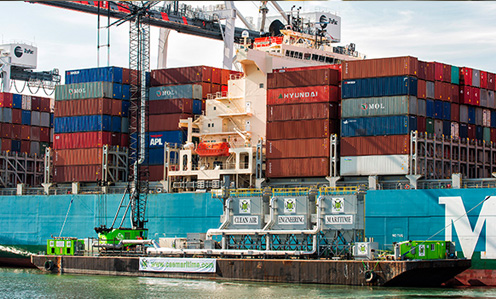

METS Systems are comprised of two principal components: a stack adaptor or flexible emissions capture device, and a catalytic filter system configured for treating PM and NOx.
The performance of the adaptor or emissions capture device can be assessed by determining the capture efficiency, while the CCF system performance is assessed by determining removal efficiencies.
Capture efficiency is monitored continuously by the METS system. As part of the CARB verification process, capture efficiency was directly measured through tracer gas dilution. A known quantity of inert tracer gas is injected at a known mass rate into the stack of the auxiliary engine. The mass rate of the tracer gas is measured at the inlet of the treatment system and compared by mass balance to the inlet concentration of the stack in order to evaluate the capture efficiency of the system.
The capture efficiency of the METS system was demonstrated on a group of vessels over a 6 month period (Figure 9).
The average capture during the CARB verification process was 91.0%. The METS is certified by CARB for 90% capture.
The METS design includes Continuous Emission Monitoring data based on CARB Method 100 with all data permanently logged and stored during operations. Instrument calibration and maintenance is based on CARB Method 100. NOx is measured on both the inlet and outlet along with volumetric flow rate and oxygen. The data was used to generate inlet and outlet mass emission rates in order to determine reduction efficiency.
The METS system NOx performance was demonstrated on vessels over a 6 month period. (Figure 10).
The average NOx removal during the CARB verification process was 91.4%. The METS is certified by CARB for 90% NOx removal.
The average ammonia slip was less than 5 ppmv.
Since there are no CARB approved methods for the continuous measurement of PM, an approach was developed based on methods used for the determination of PM from ocean-going vessels. The measurement system produces a PM concentration for both the inlet and outlet, and is reported in mg/Nm3.
This concentration data is then combined with the flow rate measurements to generate mass based loads and emission rates which were used to determine reduction efficiency during in-use performance and durability testing.
The performance of the METS system was demonstrated on multiple vessels across a 6 month period (Figure 11).
The average PM removal efficiency during the CARB verification process was 99.5%. The METS-1 is certified by CARB for 90% PM removal.
The METS system is a technically advanced and economically superior alternative control technology, approved by CARB, and already deployed; it demonstrates consistent performance and compliance with regulations.
METS removes both PM and NOx in a single, effective system that is straightforward and easy to operate. Unlike other emissions control technologies, METS is able to operate continuously, has lower re-heat costs due to lower CCF NOx activation temperature, and can be easily altered to provide SOx removal.
With barge, shore, and ship-mounted configurations of METS, vessel and terminal operators have technical options available to meet the vast majority of applications they encounter with any fleet ship calling at the port. While shore power will remain the typical method for emissions reduction, the addition of METS will allow operators to effectively meet the at-berth regulation well past the 2020 reduction limits.
The combination of CAE-M’s extensive experience in port protocol, operations and regulatory requirements, and Tri-Mer’s expertise in advanced pollution control technology makes them the perfect professional team to provide CARB approved alternative control systems that ensure compliance with current and future regulations.


Figure 9: METS-1 Capture Efficiency – Sample of capture data for 5 vessel calls

Figure 10: METS-1 NOx Performance – Sample of capture data for 7 vessel calls

Figure 11: METS-1 PM Performance – Sample of capture data for 6 vessel calls